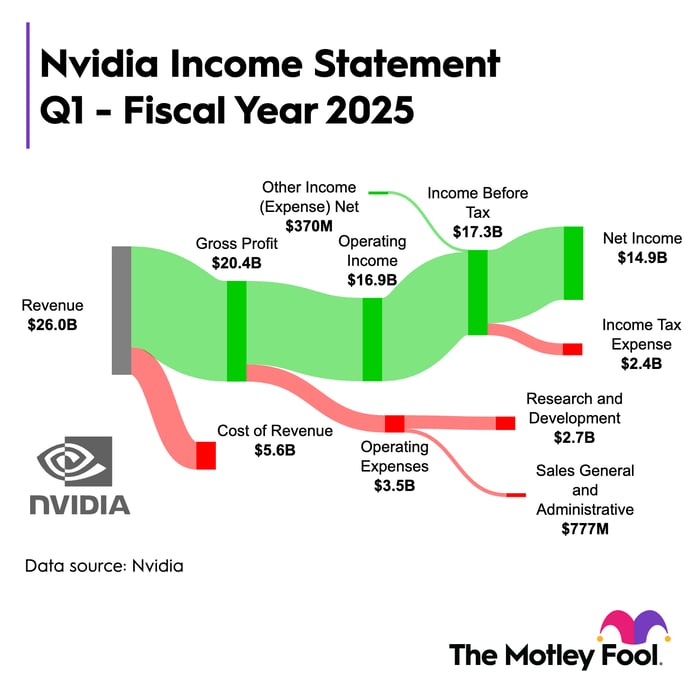Only six months into 2024, both the S&P 500 and Nasdaq Composite have posted double-digit gains and are each hovering around record levels.
One of the biggest beneficiaries of the bull market is semiconductor darling Nvidia. Shares of the chip giant are up a whopping 156% so far this year, and the company even briefly passed Microsoft as the most valuable company in the world after its market cap surpassed $3.3 trillion.
Although Nvidia is mostly recognized for its semiconductor chips, there is far more to the business. Let’s delve into how Nvidia generates revenue and what this implies for the long-term prospects surrounding artificial intelligence (AI).
Nvidia’s Revenue Composition
The image below paints a picture of Nvidia’s income statement for the first quarter of fiscal 2025 (ended April 30).

Image source: The Motley Fool.
For the quarter ending April 30, Nvidia raked in total revenue of $26 billion. Let’s explore Nvidia’s revenue breakdown by segment:
| Category | Revenue |
|---|---|
| Data Center-Compute | $19.4 billion |
| Data Center-Networking | $3.2 billion |
| Gaming | $2.6 billion |
| Professional Visualization | $0.4 billion |
| Automotive | $0.3 billion |
| OEM and Other | $0.1 billion |
Data source: Nvidia Investor Relations.
Nvidia’s data center services stand as the primary revenue source. With the flourishing demand for GPUs and their application in generative AI development, Nvidia’s stronghold in compute and networking services is evident.
Examining revenue alone falls short in evaluating a company’s financial health. Let’s now move down the income statement and scrutinize Nvidia’s expense profile and profit generation.
Impact on Cash and Liquidity
During Q1, Nvidia recorded $5.6 billion in cost of goods sold (COGS), resulting in a gross profit of $20.4 billion, equating to a robust margin profile of 78.4%.
Over recent years, Nvidia has substantially expanded its gross margin. While the high demand for AI chips plays a role, the crux lies in Nvidia’s pricing power. The company’s H100, A100, and new Blackwell chips are hailed as superior to competitors like Intel and AMD.
Industry insights indicate that Nvidia could currently hold up to 95% of the AI chip market. With such dominance, Nvidia can command premium prices for its chips compared to rivals.

In Q1, Nvidia witnessed a 39% year-over-year surge in operating expenses to $3.5 billion. Despite this notable uptick in expenses, it pales in comparison to the acceleration of Nvidia’s revenue and profits.
Therefore, Nvidia possesses ample financial resources to invest in research and development and attract top engineering talent.
The standout financial statistic from the illustration above is Nvidia’s net income of $14.9 billion. While revenue soared by 262% year over year in Q1, net income surged by a remarkable 628%.
This remarkable growth trajectory underscores Nvidia’s ability to amass substantial cash reserves.
By Q1’s end, Nvidia held $31.4 billion in cash and equivalents on the balance sheet. This amount dwarfs Nvidia’s outstanding debt, signifying robust liquidity to pay off liabilities while intensifying expenditure on innovation.
The Roaring Success of Nvidia Stock: A Golden Opportunity for Investors
Unleashing the Beast: Nvidia’s Tremendous Growth Trajectory
As the sun rises on Nvidia’s financial landscape, the dawn breaks with an awe-inspiring spectacle – a market cap now towering at a colossal $3.1 trillion, a realm that seemed an ephemeral dream just months ago. Nvidia, with the fierce grace of a soaring eagle, has consecrated its path with record-breaking strides, watching its share price defy gravity in a breathtaking ascent through the financial firmament.
Behold the chart, a testament to Nvidia’s ascendancy. While the stock price dances to a mesmerizing tune of a 171% jump over the past year, profits and earnings per share exult in a triumphant performance, basking in a more than 300% increase. The orchestra of growth orchestrates a symphony of success, with Nvidia’s earnings mightily outpacing the melodies of stock-price appreciation.
Casting our gaze upon the financial constellations, Nvidia’s price-to-earnings (P/E) multiple, at a modest 73.9, wanes compared to its former self, when it perched loftily around 240 moons ago. This metamorphosis, this alchemy of valuation, whispers a tale of undervaluation – a tantalizing prospect that dances on the tongues of astute investors.
A Jewel in the Stock Market Crown: Investing in the Future
Amidst the cacophony of market voices, the query looms – should the wise investor grasp the reins, hitch their wagon to the Nvidia star, and dare to ride forth into the horizon of wealth? With a sage nod and a gleam in the eye, the recommendation resounds – a resounding yes.
However, before the jump, a whisper of caution – delve into the wisdom of the Motley Fool Stock Advisor, a beacon of financial sagacity that illuminates the path with the 10 best stocks for the intrepid investor. While Nvidia may not grace this coveted list, the promise it bears is no less potent, no less redolent of riches untold.
Cast your thoughts back to that fateful day in 2005, when Nvidia whispered its pledge of fortune to those who listened. A humble investment of $1,000, woven with threads of faith, blossomed into a bountiful harvest – an eye-watering $723,729, a testament to the power of belief, of foresight, of trust in the market’s dance.
And as the pages of time turn, the Stock Advisor unfurls its tapestry of success, a tale of triumph that outshines the S&P 500, quadrupling its returns since 2002. The promise is radiant, the future luminous with the glow of possibility, inviting the daring investor to seize the reins of destiny and ride forth into the sunset of wealth.




